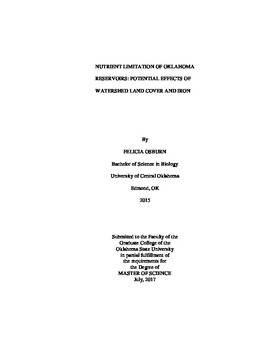| dc.contributor.advisor | Dzialowski, Andrew | |
| dc.contributor.author | Osburn, Felicia | |
| dc.date.accessioned | 2018-06-08T19:57:49Z | |
| dc.date.available | 2018-06-08T19:57:49Z | |
| dc.date.issued | 2017-07-01 | |
| dc.identifier.uri | https://hdl.handle.net/11244/300007 | |
| dc.description.abstract | Historically, phosphorus (P) has been considered to be the limiting nutrient of primary production in freshwater ecosystems, and many efforts to control eutrophication have centered around P. However, recent research suggests that other elements including nitrogen (N) and iron (Fe), may also limit primary production. In this study, 25 Oklahoma reservoirs were selected that represented a gradient in trophic state from mesotrophic to hypereutrophic, as well as gradients of high to low land cover types (forested, agricultural, and developed). Water column nutrient data was collected from each reservoir and laboratory bioassays were conducted to determine: 1) the limiting nutrient status of each reservoir, and 2) if the TN:TP ratio and/or land cover could be used to predict nutrient limitation. From the bioassay study it was found that there was primary (greater significant chl-a in a treatment relative to the control) as well as secondary (greater significant chl-a in a treatment relative to all other treatments) limitation in Oklahoma reservoirs. Nitrogen and phosphorus primarily co-limited algal biomass in 15 reservoirs, while N and P were the sole limiting nutrient in only one reservoir each. Iron was important as a secondary co-limiting nutrient when it was added in combination with both N and P in three reservoirs. Positive correlations were found between the percentage of agriculture land cover in the watershed and water column nutrient concentrations (TN and TP), and N-limited reservoirs had significantly more agricultural in their watershed, but significantly less forest compared to P limited reservoirs. The TN:TP ratios were able to correctly predict 56% of the reservoirs limiting nutrient when compared to the results of the bioassays. Combined, these results highlight the importance of including multiple elements in eutrophication research. However, additional work on the interactive effects of iron with other nutrients is needed, as it may be important for effective management of eutrophication. | |
| dc.format | application/pdf | |
| dc.language | en_US | |
| dc.rights | Copyright is held by the author who has granted the Oklahoma State University Library the non-exclusive right to share this material in its institutional repository. Contact Digital Library Services at lib-dls@okstate.edu or 405-744-9161 for the permission policy on the use, reproduction or distribution of this material. | |
| dc.title | Nutrient Limitation of Oklahoma Reservoirs: Potential Effects of Watershed Land Cover and Iron | |
| dc.contributor.committeeMember | Jeyasingh, Punidan | |
| dc.contributor.committeeMember | Storm, Daniel | |
| osu.filename | Osburn_okstate_0664M_15339.pdf | |
| osu.accesstype | Open Access | |
| dc.description.department | Interdisciplinary Science | |
| dc.type.genre | Thesis | |
| dc.type.material | text | |
